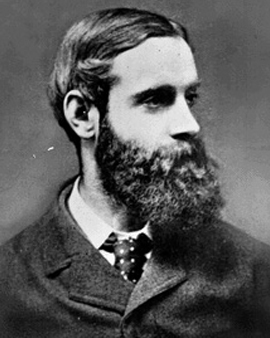Randolph Caldecott hatte eine Kindheit, die vermutlich typisch war für die viktorianische Ära. Aufgewachsen in einer Familie, die heute als kinderreich bezeichnet wird. Der Vater war Geschäftsmann und gab der Familie einen sicheren wirtschaftlichen Rahmen. Die Liebe zum Zeichnen und Gestalten entwickelte sich bei Randolph bereits in ganz jungen Jahren. Seine Lieblingsmotive waren Tiere, die er sowohl bildlich darstellte, als auch aus Holz schnitzte. In dem persönlichen Umfeld der Familie galt Rudolph als Wunderkind. Rheumatisches Fieber durchkreuzte die Zukunftspläne des talentierten Jungen. Unter Einfluss des Vaters nahm Randolph Caldecott eine Stellung in einer Bank an. Soweit die Nachwirkungen der Krankheit es zuließen, studierte Randolph Kunst in den Abendstunden. Schnell folgten Auftragsarbeiten für Zeitschriften und Magazine, die dem Künstler viel positive Resonanz einbrachten. Mehr Künstler als Banker wandte Randolph der Finanzwelt den Rücken und widmete sich der Welt der Illustrationen.
Die gesellschaftliche Entwicklung in der Zeit der Romantik hat Einfluss genommen auf das Bilderbuch. Die wachsende Schaulust der Leserschaft führte zu aufwendig illustrierten Büchern und die Kunst wurde um ein Tätigkeitsfeld erweitert: den Berufszeichnern. Besonders Bilderbücher für Kinder erlebten eine Wandlung. Die ersten Bücher für Kinder waren erzieherische Leitfäden, die die damalige Vorstellung von Pädagogik widerspiegelten. Die Kindheit unterlag strengen Idealisierungsvorstellungen. Mit der Romantik wurden Bildbücher erzählend. Einzelne Bilder und Bildfolgen erhöhten zuerst die Aussagekraft von Sachbüchern und wurden mehr und mehr zum erzählenden Element im Buch. Die Texte wurden kindgerecht poetisch. Reime, Lieder und vor allem Märchen wurden zum Mittelpunkt. Die Abbildungen verloren an Strenge und die Texte wurden von fröhlichen Kinderfiguren und Tieren in menschlicher Gestalt begleitet. Randolph Caldecott fand sich in diesem Medium wieder. Zu Beginn seiner künstlerischen Karriere bestanden die Auftraggeber aus angesehenen Magazinen und Informationsmedien, später waren es Schriftsteller der Kinderliteratur und erfolgreiche Verlagshäuser.
Die berühmtesten Werke des Künstlers haben zahlreiche Kinderaugen zum Leuchten gebracht. Caldecotts Illustrationen hoben sich aus der großen Masse der Verlagsmedien ab. Die Figuren in Randolphs Welt wirken freundlich, sie haben scheinbar immer ein Lächeln im Gesicht. Die Tiere mit menschlichen Zügen und oft in menschlicher Gestalt sind eine bildlich gewordene Darstellung von kindlichen Fantasien. Der Ideenreichtum des Künstlers wirkt unerschöpflich. Er hatte das Geschick aus einem vierzeiligen Reim ein Bilderbuch zu gestalten. Caldecott war ein Künstler, der sich im Erwachsenenalter einen Blick in die fantasievolle Kinderwelt erhalten hat. Randolph Caldecott war sich seiner Fähigkeiten bewusst. Er gilt als der erste Illustrator, der als Lohn für seine Arbeit eine Gewinnbeteiligung einging. Ein Penny pro verkauftes Exemplar sollen ihm laut Vertrag als Tantieme zugesprochen worden sein. Leider holten ihn die Spätfolgen seiner Krankheit immer wieder ein und bei den ersten Schritten in die amerikanische Welt verstarb der Künstler, bevor er vierzig Jahre alt wurde.
×





.jpg)
.jpg)
.jpg)
.jpg)
.jpg)
.jpg)
_-_(MeisterDrucke-1662789).jpg)
_-_(MeisterDrucke-1662789).jpg)
_-_(MeisterDrucke-1662786).jpg)
_-_(MeisterDrucke-1662786).jpg)
_-_(MeisterDrucke-1662678).jpg)
_-_(MeisterDrucke-1662678).jpg)
_-_(MeisterDrucke-1662645).jpg)
_-_(MeisterDrucke-1662645).jpg)
_-_(MeisterDrucke-1662792).jpg)
_-_(MeisterDrucke-1662792).jpg)
_-_(MeisterDrucke-1662794).jpg)
_-_(MeisterDrucke-1662794).jpg)
.jpg)
.jpg)
.jpg)
.jpg)
.jpg)
.jpg)
.jpg)
.jpg)
.jpg)
.jpg)
_-_(MeisterDrucke-68915).jpg)
_-_(MeisterDrucke-68915).jpg)
 - (MeisterDrucke-242897).jpg)
 - (MeisterDrucke-242897).jpg)
.jpg)
.jpg)
 - (MeisterDrucke-305856).jpg)
 - (MeisterDrucke-305856).jpg)
.jpg)
.jpg)
.jpg)
.jpg)
.jpg)
.jpg)
.jpg)
.jpg)
_-_(MeisterDrucke-1662644).jpg)
_-_(MeisterDrucke-1662644).jpg)
.jpg)
.jpg)
_-_(MeisterDrucke-1662652).jpg)
_-_(MeisterDrucke-1662652).jpg)
 - (MeisterDrucke-163159).jpg)
 - (MeisterDrucke-163159).jpg)
_-_(MeisterDrucke-1662651).jpg)
_-_(MeisterDrucke-1662651).jpg)
.jpg)
.jpg)
.jpg)
.jpg)
.jpg)
.jpg)
 - (MeisterDrucke-240265).jpg)
 - (MeisterDrucke-240265).jpg)
.jpg)
.jpg)
.jpg)
.jpg)
_-_(MeisterDrucke-1662811).jpg)
_-_(MeisterDrucke-1662811).jpg)
_-_(MeisterDrucke-1662704).jpg)
_-_(MeisterDrucke-1662704).jpg)
_-_(MeisterDrucke-1662643).jpg)
_-_(MeisterDrucke-1662643).jpg)
.jpg)
.jpg)
.jpg)
.jpg)
.jpg)
.jpg)
_-_(MeisterDrucke-1662705).jpg)
_-_(MeisterDrucke-1662705).jpg)
_-_(MeisterDrucke-1662858).jpg)
_-_(MeisterDrucke-1662858).jpg)
_-_(MeisterDrucke-1662752).jpg)
_-_(MeisterDrucke-1662752).jpg)
.jpg)
.jpg)
.jpg)
.jpg)
.jpg)
.jpg)
.jpg)
.jpg)
.jpg)
.jpg)
.jpg)
.jpg)
.jpg)
.jpg)
_-_(MeisterDrucke-1662653).jpg)
_-_(MeisterDrucke-1662653).jpg)
.jpg)
.jpg)
.jpg)
.jpg)
.jpg)
.jpg)
_-_(MeisterDrucke-1662790).jpg)
_-_(MeisterDrucke-1662790).jpg)
.jpg)
.jpg)
.jpg)
.jpg)
.jpg)
.jpg)
.jpg)
.jpg)
_-_(MeisterDrucke-1662648).jpg)
_-_(MeisterDrucke-1662648).jpg)
.jpg)
.jpg)
_-_(MeisterDrucke-1662650).jpg)
_-_(MeisterDrucke-1662650).jpg)
.jpg)
.jpg)
_-_(MeisterDrucke-1662647).jpg)
_-_(MeisterDrucke-1662647).jpg)
 - (MeisterDrucke-179802).jpg)
 - (MeisterDrucke-179802).jpg)
.jpg)
.jpg)
 - (MeisterDrucke-146151).jpg)
 - (MeisterDrucke-146151).jpg)
_-_(MeisterDrucke-1662810).jpg)
_-_(MeisterDrucke-1662810).jpg)
_-_(MeisterDrucke-1084413).jpg)
_-_(MeisterDrucke-1084413).jpg)
 - (MeisterDrucke-275993).jpg)
 - (MeisterDrucke-275993).jpg)
_-_(MeisterDrucke-1662657).jpg)
_-_(MeisterDrucke-1662657).jpg)
 - (MeisterDrucke-305160).jpg)
 - (MeisterDrucke-305160).jpg)
.jpg)
.jpg)
.jpg)
.jpg)
 - (MeisterDrucke-265710).jpg)
 - (MeisterDrucke-265710).jpg)
.jpg)
.jpg)
.jpg)
.jpg)
.jpg)
.jpg)
.jpg)
.jpg)
.jpg)
.jpg)
.jpg)
.jpg)
.jpg)
.jpg)
_-_(MeisterDrucke-1662707).jpg)
_-_(MeisterDrucke-1662707).jpg)
.jpg)
.jpg)
.jpg)
.jpg)
.jpg)
.jpg)
.jpg)
.jpg)
.jpg)
.jpg)
.jpg)
.jpg)
_-_(MeisterDrucke-1662793).jpg)
_-_(MeisterDrucke-1662793).jpg)
.jpg)
.jpg)
.jpg)
.jpg)
.jpg)
.jpg)
.jpg)
.jpg)
.jpg)
.jpg)
.jpg)
.jpg)
 - (MeisterDrucke-222612).jpg)
 - (MeisterDrucke-222612).jpg)
.jpg)
.jpg)
 - (MeisterDrucke-300702).jpg)
 - (MeisterDrucke-300702).jpg)
 - (MeisterDrucke-269970).jpg)
 - (MeisterDrucke-269970).jpg)
.jpg)
.jpg)






